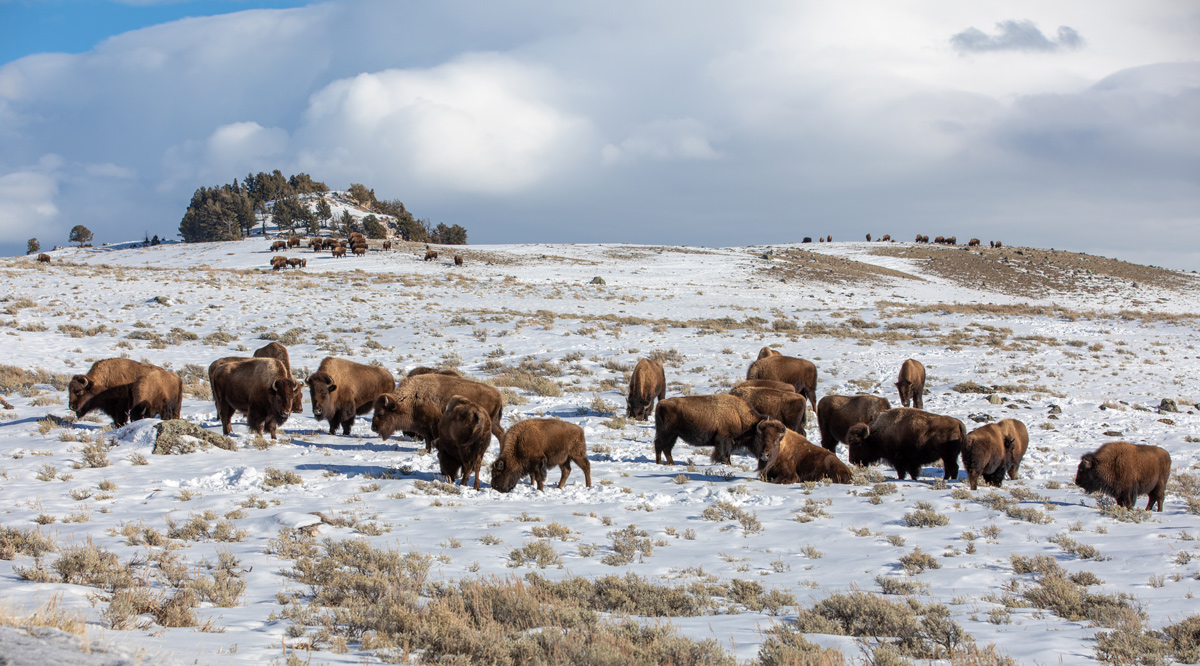Nine men leave Fort Mandan to hunt bison but return with only a white-tailed jackrabbit. A Hidatsa man comes for his wife who is seeking refuge at the fort, and Charbonneau and one of the enlisted men arrive late at one of the Hidatsa villages.
The New Year with a Bang!
by Yellowstone Public Radio[1]Originally aired weekdays by Yellowstone Public Radio during the Bicentennial observance of 2003-2006. Narrated by Hal Hansen. Scripts by Whit Hansen and Ed Jacobson. Produced by Leni Holliman. © … Continue reading
Hunting Buffalo
Some buffalow came near our fort, 9 men went out but killed none of them. one of the men killed a butiful white hair [white-tailed jackrabbit] which is common in this country.
—William Clark
Hidatsa Woman
Edward S. Curtis (1868–1952)
Northwestern University Library, Edward S. Curtis’s “The North American Indian,” 2003. http://curtis.library.northwestern.edu/site_curtis. [2]Edward S. Curtis, The North American Indian (1907-1930) v.04, The Apsaroke, or Crows. The Hidatsa ([Seattle, Cambridge: The University Press], 1909), v. 4, facing page 148.
Providing Refuge
Several Indians visit us to day & a Gross Ventre came after his wife, who had been much abused, & come here for Protection.
—William Clark
Charbonneau’s Hidatsa Envoy
Charbonneau arrived at dark, with a man Engaged to the Americans, desired Mr. McK. [ Charles McKenzie] to get ready to go to the Borgnes Camp with Charbonneau, next morning & gave the American 1 knife for his voyage he having none.
—François-Antoine Larocque[3]3 January 1805, W. Raymond Wood and Thomas D. Thiessen, Early Fur Trade on the Northern Plains: Canadian Traders among the Mandan and Hidatsa Indians, 1738–1818 (Norman: University of Oklahoma … Continue reading
Weather Diary
Ther. at rise
Weather Wind at rise
Thert. at 4 P.M. Weather Wind at 4 P.M. River 14 below [0] cloudy N. 4 below snow S E the Snow was not considerable the ground is now covered 9 inches deep—
—Meriwether Lewis[4]To assist the reader, the editor of this web page has omitted the date column, merged the “River” columns, and spelled out some abbreviations.
Experience the Lewis and Clark Trail
The Lewis and Clark Trail Experience—our sister site at lewisandclark.travel—connects the world to people and places on the Lewis and Clark Trail.
Plan a trip related to January 3, 1805:

Fort Mandan is a High Potential Historic Site along the Lewis and Clark National Historic Trail managed by the U.S. National Park Service. The North Dakota Department of Parks and Recreation manages a modern reconstruction and the Lewis and Clark Interpretive Center located at US Hwy 83 and ND Hwy 200A.
Knife River Indian Villages National Historic Site is a High Potential Historic Site along the Lewis and Clark National Historic Trail managed by the U.S. National Park Service. A unit of the National Park System, the site is located at 564 County Road 37, one-half mile north of Stanton, North Dakota. It has exhibits, trails, and a visitor center.
Notes
| ↑1 | Originally aired weekdays by Yellowstone Public Radio during the Bicentennial observance of 2003-2006. Narrated by Hal Hansen. Scripts by Whit Hansen and Ed Jacobson. Produced by Leni Holliman. © 2003 by Yellowstone Public Radio. |
|---|---|
| ↑2 | Edward S. Curtis, The North American Indian (1907-1930) v.04, The Apsaroke, or Crows. The Hidatsa ([Seattle, Cambridge: The University Press], 1909), v. 4, facing page 148. |
| ↑3 | 3 January 1805, W. Raymond Wood and Thomas D. Thiessen, Early Fur Trade on the Northern Plains: Canadian Traders among the Mandan and Hidatsa Indians, 1738–1818 (Norman: University of Oklahoma Press, 1985), 146–47. |
| ↑4 | To assist the reader, the editor of this web page has omitted the date column, merged the “River” columns, and spelled out some abbreviations. |




